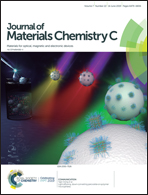How cyclic chain topology can reduce the crystallization rate of poly(3-hexylthiophene) and promote the formation of liquid crystalline phases in comparison with linear analogue chains†
Abstract
We have studied how cyclic topology affects the crystallization and morphology of π-conjugated poly(3-hexylthiophene) (P3HT) molecules by comparing linear and cyclic analogues for the first time, with three different chain lengths. We employ a range of experimental techniques including wide-angle X-ray scattering (WAXS), polarized light optical microscopy (PLOM), differential scanning calorimetry (DSC) and a combination of polarized light optical microscopy (PLOM) and spectroscopy (S). The crystallization and melting points, melting/crystallization enthalpies, and overall crystallization kinetics of cyclic P3HTs are found to be substantially lower than their linear counterparts. The results are explained by the higher rigidity of cyclic molecules, as predicted by density functional theory (DFT) calculations, in the low molecular weight range explored here, in comparison with linear P3HT chains. Additionally, we have found that cyclic P3HT can form liquid crystalline phases above their crystalline melting points and a new crystal form at lower temperatures. PLOM, WAXS, DSC and PLOM-S results indicate that cyclic P3HTs display bipolar and concentric nematic textures that disappear at a well-defined nematic-isotropic transition temperature. Such liquid crystalline textures are completely absent in the linear P3HT analogues studied here. We conclude that the cyclic topology induces the formation of liquid crystalline phases as the rigid P3HT oligomers can self-assemble above their crystalline melting temperatures.



 Please wait while we load your content...
Please wait while we load your content...